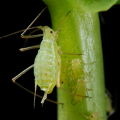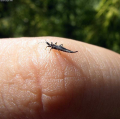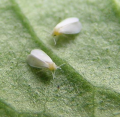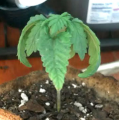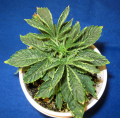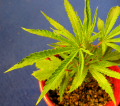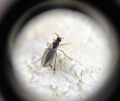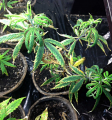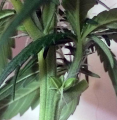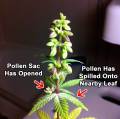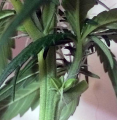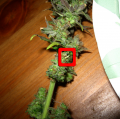Root Rot
Cannabis Root Rot - Slimy brown roots.

Root Rot Leaf Symptoms: burnt edges or tips; yellow, bronze or brown spots or stripes;nutrient deficiencies; clawing and curled edges; other unusual leaf symptoms.
Important: The Following Roots Are Stained From Nutrients - They Are NOT Brown From Root Rot
(the easiest way to tell the difference between healthy stained roots and sick roots is root rot looks slimy, while you can see each individual "strand" on healthy cannabis roots)
What To Do About Marijuana Root Rot & Root Slime
Problem: Your cannabis plant starts drooping, leaves start getting sick, and roots are brown,smelly and/or slimy. These are all symptoms of cannabis root rot.Roots need water, but if they are get too much water without enough oxygen they are much more s usceptible to root rot. This is often caused by too-hot conditions, overwatering, and/or not enough bubbles dissolving oxygen into a DWC water reservoir.
Healthy roots are white to cream-colored while roots affected by root rot are brownish and actually may even smell like mildew or rotting.

Healthy roots are white to cream-colored while roots affected by root rot are brownish and actually may even smell like mildew or rotting.
Plants affected by root rot will spontaneously start losing their leaves, leaves become yellow or bronze.The plants start drooping, wilting, or otherwise looking like they're dying.
The very first sign of root rot in cannabis (besides brown roots) is usually wilting or drooping.Sometimes the plant will not wilt, or will recover from wilting while still showing other signs of root
rot. Although wilting is common, you cannot be sure your plant doesn't have root rot just because it's not wilting. It's much more important to look at the roots in order to accurately diagnose root rot.


The wilting will soon be followed by other symptoms to the leaves, especially burning, brown spots,nutrient deficiencies, spotting, and other unusual leaf symptoms.


You will also notice that affected plants will start drinking less water. If you notice these symptoms in your cannabis plant, then it can't hurt to try all the suggestions for stopping root rot.


It's important to notes that damage is permanent to both the roots and the leaves.
Old brown roots will never turn white again. Brown leaves will never turn green again. You need to insteaed be looking at new growth for signs of root rot recovery.
A recovering plant will be able to make new growth, but it's old infected roots will likely never recover. Instead, you know that recovery is happening when new white roots start growing from the old
brown ones.
Root rot mostly affects hydroponic systems, but can also result from over watering your plants in soil or other medium. Basically anytime the roots are sitting in water, they are at risk of devloping
root rot.
Plants may appear overwatered or droopy, sometimes plants wilt overnight.
Brown, slimey, smelly roots.
Plant leaves often start turning yellow or white.
Leaves start dying and falling off rapidly
Oftentime you'll see what appears to be a random mix of nutrient deficiencies on the leaves - this is due to the fact that the plant can't absorb nutrients properly at the roots even if they're there.
Plants drink much less water than usual.

Now that you know what root rot looks like, it's time for the cannabis root rot solution!
Solution: It can be tough to get rid of root rot and many people feel it's easier to just scrap the plant and start over. However, there are proven techniques that will cure your plant of root rot problems. In order to get rid of root rot successfully, you need to take a two pronged approach.
You will need to treat the plant's root directly and you will also need change the plant's environment so that root rot no longer has a good place to grow.
If you don't fix the environmental causes of root rot, then it will just keep coming back no matter what you do. Therefore, it's important to go through the below list and make sure you're covering
all your bases to prevent a re-occurrence. It's also important to note that affected roots will likely never recover, just like how discolored leaves on the plant will never recover. What you're looking for
is new, healthy white root growth.
How to prevent and treat root rot:
1. Lower the temperature of the grow space, which also lowers the temerature of the water in your reservoir.Water can't hold much dissolved oxygen at higher temperatures and your plants need oxygen to "breathe."Getting more oxygen to the roots not only prevents root rot, it makes your plants grow much faster.If it's too hot in the grow space, you're much more likely to run into root rot. The maximum recommended temperature for the water in your reservoir is around 72°F (22°C). When using a great supplement like
Hydroguard you can usually keep the temps a bit higher without as much of a problem.
2. Some people like to add beneficial bacteria to their water to help prevent and treat root-related plant diseases and help make nutrients available to the plant. Some of the formulas available are
Hydroguard, Aquashield, Piranha, VooDoo Juice, Great White (Great White has great reviews, yet is obscenely expensive), Subculture B, Rooters, and Plant Savers. Most of these can be used with both hydro and soil grows. I personally recommend Hydroguard because I've used it successfully to treat Root Rot.
3. As I mentioned, it is incredibly beneficial to try to get as much oxygen as possible dissolved in your water. Therefore it's a good idea to buy a BIG air pump and big air stones for your hydroponic system.
The more bubbles and surface agitation, the better, as this dissolves more oxygen into the water. Root rot cannot thrive in an oxygen-rich environment and your plants roots will love it.
4. If you have a hydroponic system, it's best to change your reservoir water regularly.I recommend trying to change your water at least every two weeks, though many growers recommend you change
the reservoir once a week. Regularly changing your water will also help your plants get better access to nutrients, and help prevent deficiencies and toxicities.
5. In a hydroponic system, make sure that any dead roots, dead leaves or other types of plant debris doesn't get into the reservoir because they will provide a breeding ground for bad bacteria as they start
rotting. If you do notice organic matter in the res, fish it out as soon as possible.
6. Don't let any light get to your roots or reservoir water, as it provides heat and light which will promote the growth of bacteria.
7. You will need to keep your grow area as clean as possible at all times to stop bacteria before it starts.Before you begin your grow, you should also thoroughly clean all grow-related items to kill all bacteria.
8. Some people recommend treating root rot with H2O2, also known as hydrogen peroxide. While adding hydrogen peroxide to your water will kill all bacteria including root rot,it is only effective in your
system for a day or since the H2O2 is quickly converted to oxygen and water. Therefore, if you use hydrogen peroxide as a treatment for root rot, you will need to treat your water daily to prevent re-occurances. I have tried used commercial grade H2O2 before, and I was never able to use it to get rid of root rot, so this is NOT RECOMMENDED!
Your plant can completely recover from root rot as long as you catch the problem early enough,so it's important to stay vigilent of root rot during your first couple of grows, expecially when growing
with hydroponics.
Don't Use Hydrogen Peroxide (H2O2)! H2O2 is temperarily effective at best when it comes to getting rid of root rot. It makes me so sad when people tell growers to use H2O2 (hydrogen peroxide) to kill root rot.
Even the commercial grade stuff just doesn't work (and I've tried)!
All H2O2 does is cause bubbling near the dead brown roots (or any organic matter), which is why I think people believe it's helping. In my experience it doesn't help the plants themselves (they don't look any
better), and what's worse, all the H2O2 will be completely gone from the water within 24 hours.

H2O2 kills most of the bacteria in the reservoir, including any good bacteria, and does absolutely nothing to address the underlying problem. Although H2O2 does kill bad bacteria, it leaves enough of it there to repopulate your reservoir. As common as the advice to use H2O2 for root rot is, I've never seen a case by a real grower who was actually able to get rid of root rot with H2O2.
Recommend Botanicare Hydroguard (the newer, improved version of Botanicare's popular "Aquashield" root supplement) for marijuana root problems because I've used it successfully to get rid of a terrible case
of Root Rot (and by 'successul' I mean new white roots exploded out of the old mushy brown ones and I was able to eventually harvest the buds - look at the pics below).
Hydroguard (and their old supplement Aquashield) are also much cheaper than most other similar root treatments.
One important thing to note is that after you treat the cause of root rot, the old brown roots will likely never recover. Neither will the damaged leaves!
Take a look at what happens with the roots from using a supplment like Hydroguard or Aquashield.
With recovery...
What you are looking for is new healthy white roots growing out of the old brown roots.Eventually, as the root ball gets bigger, you will no longer be able to see the old brown roots.After you start noticing a recovery, some growers will snip off old dead roots, but I often don't.
Before - Roots Just Got Root Rot


Roots are beginning to recover...
Notice the new white roots growing out of the old brown dead ones within just a day or two of receiving.Aquashield in the reservoir. By this point, the plant has stopped showing any new symptoms and appears
to be growing normally.

Roots are now mostly recovered below...
Notice that you can barely see any signs of the old brown, and all the new roots generally appear white and healthy. The plants on top are lush, healthy, and fast-growing, though the old burnt leaves never recovered.
Yuck! Follow This Tutorial and Never Get Root Rot Again!

Leaf Color:
Edges Appear Brown or Burnt
Pale Color Leaves
Yellow Leaves - New Growth
Yellow Leaves - Lower, older leaves
Brown or Dark Spots
Leaf Symptoms:
Leaf Edges Appear Burnt
Leaf Tips Appear Burnt
Leaf Tips Die
Spots
Old Leaves Dropping Off
Slow Growth
Abnormal Growth
Leaves Curl Under
Leaves Curl Upwards
Wilting / Drooping
Plant Symptoms:
Weak Stems
Slow Growth
Plant Wilting / Drooping
Root Symptoms:
Brown
Smelly
Mushy
Slow Growing
Cannabis Root Rot - Slimy brown roots.

Root Rot Leaf Symptoms: burnt edges or tips; yellow, bronze or brown spots or stripes;nutrient deficiencies; clawing and curled edges; other unusual leaf symptoms.

Important: The Following Roots Are Stained From Nutrients - They Are NOT Brown From Root Rot

(the easiest way to tell the difference between healthy stained roots and sick roots is root rot looks slimy, while you can see each individual "strand" on healthy cannabis roots)
What To Do About Marijuana Root Rot & Root Slime
Problem: Your cannabis plant starts drooping, leaves start getting sick, and roots are brown,smelly and/or slimy. These are all symptoms of cannabis root rot.Roots need water, but if they are get too much water without enough oxygen they are much more s usceptible to root rot. This is often caused by too-hot conditions, overwatering, and/or not enough bubbles dissolving oxygen into a DWC water reservoir.
Healthy roots are white to cream-colored while roots affected by root rot are brownish and actually may even smell like mildew or rotting.

Healthy roots are white to cream-colored while roots affected by root rot are brownish and actually may even smell like mildew or rotting.
Plants affected by root rot will spontaneously start losing their leaves, leaves become yellow or bronze.The plants start drooping, wilting, or otherwise looking like they're dying.
The very first sign of root rot in cannabis (besides brown roots) is usually wilting or drooping.Sometimes the plant will not wilt, or will recover from wilting while still showing other signs of root
rot. Although wilting is common, you cannot be sure your plant doesn't have root rot just because it's not wilting. It's much more important to look at the roots in order to accurately diagnose root rot.


The wilting will soon be followed by other symptoms to the leaves, especially burning, brown spots,nutrient deficiencies, spotting, and other unusual leaf symptoms.


You will also notice that affected plants will start drinking less water. If you notice these symptoms in your cannabis plant, then it can't hurt to try all the suggestions for stopping root rot.

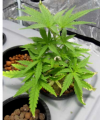
It's important to notes that damage is permanent to both the roots and the leaves.
Old brown roots will never turn white again. Brown leaves will never turn green again. You need to insteaed be looking at new growth for signs of root rot recovery.
A recovering plant will be able to make new growth, but it's old infected roots will likely never recover. Instead, you know that recovery is happening when new white roots start growing from the old
brown ones.
Root rot mostly affects hydroponic systems, but can also result from over watering your plants in soil or other medium. Basically anytime the roots are sitting in water, they are at risk of devloping
root rot.
Plants may appear overwatered or droopy, sometimes plants wilt overnight.
Brown, slimey, smelly roots.
Plant leaves often start turning yellow or white.
Leaves start dying and falling off rapidly
Oftentime you'll see what appears to be a random mix of nutrient deficiencies on the leaves - this is due to the fact that the plant can't absorb nutrients properly at the roots even if they're there.
Plants drink much less water than usual.

Now that you know what root rot looks like, it's time for the cannabis root rot solution!
Solution: It can be tough to get rid of root rot and many people feel it's easier to just scrap the plant and start over. However, there are proven techniques that will cure your plant of root rot problems. In order to get rid of root rot successfully, you need to take a two pronged approach.
You will need to treat the plant's root directly and you will also need change the plant's environment so that root rot no longer has a good place to grow.
If you don't fix the environmental causes of root rot, then it will just keep coming back no matter what you do. Therefore, it's important to go through the below list and make sure you're covering
all your bases to prevent a re-occurrence. It's also important to note that affected roots will likely never recover, just like how discolored leaves on the plant will never recover. What you're looking for
is new, healthy white root growth.
How to prevent and treat root rot:
1. Lower the temperature of the grow space, which also lowers the temerature of the water in your reservoir.Water can't hold much dissolved oxygen at higher temperatures and your plants need oxygen to "breathe."Getting more oxygen to the roots not only prevents root rot, it makes your plants grow much faster.If it's too hot in the grow space, you're much more likely to run into root rot. The maximum recommended temperature for the water in your reservoir is around 72°F (22°C). When using a great supplement like
Hydroguard you can usually keep the temps a bit higher without as much of a problem.
2. Some people like to add beneficial bacteria to their water to help prevent and treat root-related plant diseases and help make nutrients available to the plant. Some of the formulas available are
Hydroguard, Aquashield, Piranha, VooDoo Juice, Great White (Great White has great reviews, yet is obscenely expensive), Subculture B, Rooters, and Plant Savers. Most of these can be used with both hydro and soil grows. I personally recommend Hydroguard because I've used it successfully to treat Root Rot.
3. As I mentioned, it is incredibly beneficial to try to get as much oxygen as possible dissolved in your water. Therefore it's a good idea to buy a BIG air pump and big air stones for your hydroponic system.
The more bubbles and surface agitation, the better, as this dissolves more oxygen into the water. Root rot cannot thrive in an oxygen-rich environment and your plants roots will love it.
4. If you have a hydroponic system, it's best to change your reservoir water regularly.I recommend trying to change your water at least every two weeks, though many growers recommend you change
the reservoir once a week. Regularly changing your water will also help your plants get better access to nutrients, and help prevent deficiencies and toxicities.
5. In a hydroponic system, make sure that any dead roots, dead leaves or other types of plant debris doesn't get into the reservoir because they will provide a breeding ground for bad bacteria as they start
rotting. If you do notice organic matter in the res, fish it out as soon as possible.
6. Don't let any light get to your roots or reservoir water, as it provides heat and light which will promote the growth of bacteria.
7. You will need to keep your grow area as clean as possible at all times to stop bacteria before it starts.Before you begin your grow, you should also thoroughly clean all grow-related items to kill all bacteria.
8. Some people recommend treating root rot with H2O2, also known as hydrogen peroxide. While adding hydrogen peroxide to your water will kill all bacteria including root rot,it is only effective in your
system for a day or since the H2O2 is quickly converted to oxygen and water. Therefore, if you use hydrogen peroxide as a treatment for root rot, you will need to treat your water daily to prevent re-occurances. I have tried used commercial grade H2O2 before, and I was never able to use it to get rid of root rot, so this is NOT RECOMMENDED!
Your plant can completely recover from root rot as long as you catch the problem early enough,so it's important to stay vigilent of root rot during your first couple of grows, expecially when growing
with hydroponics.
Don't Use Hydrogen Peroxide (H2O2)! H2O2 is temperarily effective at best when it comes to getting rid of root rot. It makes me so sad when people tell growers to use H2O2 (hydrogen peroxide) to kill root rot.
Even the commercial grade stuff just doesn't work (and I've tried)!
All H2O2 does is cause bubbling near the dead brown roots (or any organic matter), which is why I think people believe it's helping. In my experience it doesn't help the plants themselves (they don't look any
better), and what's worse, all the H2O2 will be completely gone from the water within 24 hours.

H2O2 kills most of the bacteria in the reservoir, including any good bacteria, and does absolutely nothing to address the underlying problem. Although H2O2 does kill bad bacteria, it leaves enough of it there to repopulate your reservoir. As common as the advice to use H2O2 for root rot is, I've never seen a case by a real grower who was actually able to get rid of root rot with H2O2.
Recommend Botanicare Hydroguard (the newer, improved version of Botanicare's popular "Aquashield" root supplement) for marijuana root problems because I've used it successfully to get rid of a terrible case
of Root Rot (and by 'successul' I mean new white roots exploded out of the old mushy brown ones and I was able to eventually harvest the buds - look at the pics below).
Hydroguard (and their old supplement Aquashield) are also much cheaper than most other similar root treatments.
One important thing to note is that after you treat the cause of root rot, the old brown roots will likely never recover. Neither will the damaged leaves!
Take a look at what happens with the roots from using a supplment like Hydroguard or Aquashield.
With recovery...
What you are looking for is new healthy white roots growing out of the old brown roots.Eventually, as the root ball gets bigger, you will no longer be able to see the old brown roots.After you start noticing a recovery, some growers will snip off old dead roots, but I often don't.
Before - Roots Just Got Root Rot


Roots are beginning to recover...
Notice the new white roots growing out of the old brown dead ones within just a day or two of receiving.Aquashield in the reservoir. By this point, the plant has stopped showing any new symptoms and appears
to be growing normally.

Roots are now mostly recovered below...
Notice that you can barely see any signs of the old brown, and all the new roots generally appear white and healthy. The plants on top are lush, healthy, and fast-growing, though the old burnt leaves never recovered.

Yuck! Follow This Tutorial and Never Get Root Rot Again!
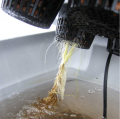
Leaf Color:
Edges Appear Brown or Burnt
Pale Color Leaves
Yellow Leaves - New Growth
Yellow Leaves - Lower, older leaves
Brown or Dark Spots
Leaf Symptoms:
Leaf Edges Appear Burnt
Leaf Tips Appear Burnt
Leaf Tips Die
Spots
Old Leaves Dropping Off
Slow Growth
Abnormal Growth
Leaves Curl Under
Leaves Curl Upwards
Wilting / Drooping
Plant Symptoms:
Weak Stems
Slow Growth
Plant Wilting / Drooping
Root Symptoms:
Brown
Smelly
Mushy
Slow Growing







